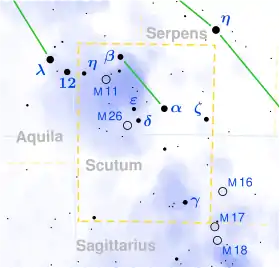Beta Scuti
Beta Scuti, Latinized from β Scuti, is a binary star system in the southern constellation Scutum. Based upon an annual parallax shift of 3.56 mas as seen from Earth,[1] it is located approximately 920 light years from the Sun. The primary component has an apparent visual magnitude of +4.22 and is radiating about 1,270 times the luminosity of the Sun from its outer atmosphere at an effective temperature of 4,622 K.[2] This yellow-hued star is a G-type bright giant with a stellar classification of G4 IIa.[3]
| Observation data Epoch J2000 Equinox J2000 | |
|---|---|
| Constellation | Scutum |
| Right ascension | 18h 47m 10.47250s[1] |
| Declination | −4° 44′ 52.3271″[1] |
| Apparent magnitude (V) | 4.22[2] |
| Characteristics | |
| Spectral type | G4IIa[3] |
| U−B color index | +0.84[4] |
| B−V color index | +1.09[4] |
| Astrometry | |
| Radial velocity (Rv) | −21.30[5] km/s |
| Proper motion (μ) | RA: −8.44[1] mas/yr Dec.: −16.37[1] mas/yr |
| Parallax (π) | 3.56 ± 0.43[1] mas |
| Distance | approx. 900 ly (approx. 280 pc) |
| Absolute magnitude (MV) | -2.99[6] |
| Orbit[7] | |
| Primary | Beta Scuti A |
| Companion | Bet Scuti B |
| Period (P) | 834 days |
| Semi-major axis (a) | 2.8 mas |
| Eccentricity (e) | 0.350 |
| Inclination (i) | 105.9° |
| Longitude of the node (Ω) | 288.1° |
| Periastron epoch (T) | 2422480.9 |
| Argument of periastron (ω) (secondary) | 33.9° |
| Details | |
| Luminosity | 1,270[2] L☉ |
| Surface gravity (log g) | 0.94[8] cgs |
| Temperature | 4,622[2] K |
| Metallicity [Fe/H] | -0.16[6] dex |
| Rotational velocity (v sin i) | 7.8[9] km/s |
| Other designations | |
| Database references | |
| SIMBAD | data |
This is a spectroscopic binary with an orbital period of 2.3 years and eccentricity around 0.35.[10] The secondary is about 3.3 magnitudes dimmer than the primary and estimated as type B9 based on the flux of far-ultraviolet radiation.[11]
The secondary was directly detected with a magnitude difference of 3.6 at a separation of about 17 milli-arcseconds using observations from the Navy Precision Optical Interferometer.[12] This detection was significant as observations with the Hubble Space Telescope which indicated a companion star was present were not definitive.[13] With an orbit and a parallax the sum of the masses of the two stars can be determined via a dynamical parallax. [14] This eventually can yield a precise mass for the evolved giant primary star.
Beta Scuti was a latter designation of 6 Aquilae.[15]
References
- Van Leeuwen, F. (2007). "Validation of the new Hipparcos reduction". Astronomy and Astrophysics. 474 (2): 653–664. arXiv:0708.1752. Bibcode:2007A&A...474..653V. doi:10.1051/0004-6361:20078357. Vizier catalog entry
- Mallik, Sushma V. (December 1999), "Lithium abundance and mass", Astronomy and Astrophysics, 352: 495–507, Bibcode:1999A&A...352..495M
- Keenan, Philip C.; McNeil, Raymond C. (1989). "The Perkins catalog of revised MK types for the cooler stars". The Astrophysical Journal Supplement Series. 71: 245. Bibcode:1989ApJS...71..245K. doi:10.1086/191373.
- Ducati, J. R. (2002). "VizieR Online Data Catalog: Catalogue of Stellar Photometry in Johnson's 11-color system". CDS/ADC Collection of Electronic Catalogues. 2237. Bibcode:2002yCat.2237....0D.
- Pourbaix, D.; Tokovinin, A. A.; Batten, A. H.; Fekel, F. C.; Hartkopf, W. I.; Levato, H.; Morrell, N. I.; Torres, G.; Udry, S. (2004). "SB9: The ninth catalogue of spectroscopic binary orbits". Astronomy and Astrophysics. 424 (2): 727–732. arXiv:astro-ph/0406573. Bibcode:2004A&A...424..727P. doi:10.1051/0004-6361:20041213.
- Anderson, E.; Francis, Ch. (2012). "XHIP: An extended hipparcos compilation". Astronomy Letters. 38 (5): 331. arXiv:1108.4971. Bibcode:2012AstL...38..331A. doi:10.1134/S1063773712050015. Vizier catalog entry
- Ren, Shulin (2013). "Hipparcos Photocentric Orbits of 72 Single-lined Spectroscopic Binaries". The Astronomical Journal. 145 (3): 81. Bibcode:2013AJ....145...81R. doi:10.1088/0004-6256/145/3/81.
- Soubiran, Caroline; Le Campion, Jean-François; Brouillet, Nathalie; Chemin, Laurent (2016). "The PASTEL catalogue: 2016 version". Astronomy & Astrophysics. 591: A118. arXiv:1605.07384. Bibcode:2016A&A...591A.118S. doi:10.1051/0004-6361/201628497.
- De Medeiros, J. R.; Mayor, M. (1999). "A catalog of rotational and radial velocities for evolved stars". Astronomy and Astrophysics Supplement Series. 139 (3): 433. arXiv:astro-ph/0608248. Bibcode:1999A&AS..139..433D. doi:10.1051/aas:1999401. Vizier catalog entry
- Pourbaix, D.; Tokovinin, A. A.; Batten, A. H.; Fekel, F. C.; Hartkopf, W. I.; Levato, H.; Morrell, N. I.; Torres, G.; Udry, S. (2004). "SB9: The ninth catalogue of spectroscopic binary orbits". Astronomy and Astrophysics. 424 (2): 727–732. arXiv:astro-ph/0406573. Bibcode:2004A&A...424..727P. doi:10.1051/0004-6361:20041213.
- Parsons, Sidney B.; Ake, Thomas B. (1998). "Ultraviolet and Optical Studies of Binaries with Luminous Cool Primaries and Hot Companions. V. The Entire IUE Sample". The Astrophysical Journal Supplement Series. 119 (1): 83. Bibcode:1998ApJS..119...83P. doi:10.1086/313152.
- Hutter, D. J.; Zavala, R. T.; Tycner, C.; Benson, J. A.; Hummel, C. A.; Sanborn, J.; Franz, O. G.; Johnston, K. J. (2016). "Surveying the Bright Stars by Optical Interferometry. I. A Search for Multiplicity among Stars of Spectral Types F-K". Astrophysical Journal Supplement Series. 227 (1): 4. arXiv:1609.05254. Bibcode:2016ApJS..227....4H. doi:10.3847/0067-0049/227/1/4.
- Parsons, S. B.; Franz, O. G.; Wassermann, L. H. (2005). "The Fine Guidance Sensor Orbit of the G4 Bright Giant HD 173764". Astronomical Journal. 129 (3): 1700. Bibcode:2005AJ....129.1700P. doi:10.1086/427853.
- Heintz, Wulff D. (1978). Double Stars - Springer. doi:10.1007/978-94-009-9836-0. ISBN 978-90-277-0886-1.
- Wagman, M. (August 1987). "Flamsteed's Missing Stars". Journal for the History of Astronomy. 18 (3): 212. Bibcode:1987JHA....18..209W. doi:10.1177/002182868701800305.
